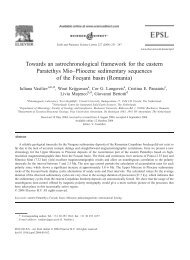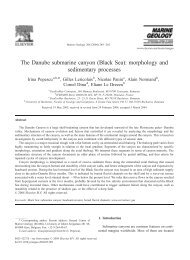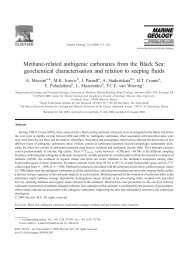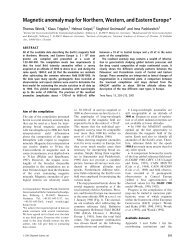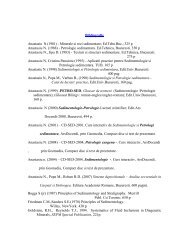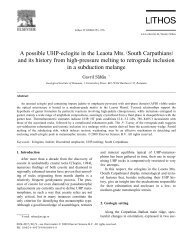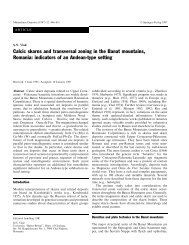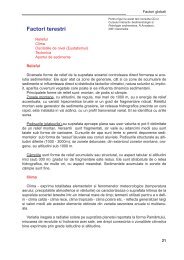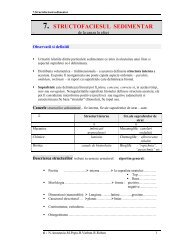Lateglacial and early Holocene vegetation ... - geo.edu.ro
Lateglacial and early Holocene vegetation ... - geo.edu.ro
Lateglacial and early Holocene vegetation ... - geo.edu.ro
Create successful ePaper yourself
Turn your PDF publications into a flip-book with our unique Google optimized e-Paper software.
L. Bj .orkman et al. / Quaternary Science Reviews 21 (2002) 1039–1059 1057<br />
a<strong>ro</strong>und 14,700 cal. years BP correlates in time to the<br />
start of the first deglacial warming phase (GI-1e) of the<br />
GRIP ice core event stratigraphy (Bj.orck et al., 1998;<br />
Walker et al., 1999). The lowermost mine<strong>ro</strong>genic<br />
sediments in Steregoiu, which were deposited before c.<br />
14,700 cal. years BP, could then correspond to the end of<br />
the last distinctly cold period of the Last Glacial<br />
Maximum (GS-2). Prevailing cold climatic conditions<br />
are indicated by the open <st<strong>ro</strong>ng>vegetation</st<strong>ro</strong>ng>, which consisted of<br />
a patchy mosaic with low shrubs, grass, sedges <st<strong>ro</strong>ng>and</st<strong>ro</strong>ng><br />
herbs <st<strong>ro</strong>ng>and</st<strong>ro</strong>ng> patches of un-vegetated g<strong>ro</strong>und. Successively<br />
warmer climatic conditions between c. 14,700 <st<strong>ro</strong>ng>and</st<strong>ro</strong>ng><br />
14,050 cal. years BP (corresponding to GI-1e) can be<br />
inferred f<strong>ro</strong>mthe transition f<strong>ro</strong>mopen <st<strong>ro</strong>ng>vegetation</st<strong>ro</strong>ng> with<br />
scattered Pinus individuals to open forest with Pinus <st<strong>ro</strong>ng>and</st<strong>ro</strong>ng><br />
Betula. The marked r<st<strong>ro</strong>ng>edu</st<strong>ro</strong>ng>ction in tree cover <st<strong>ro</strong>ng>and</st<strong>ro</strong>ng> the<br />
renewed spread of open <st<strong>ro</strong>ng>vegetation</st<strong>ro</strong>ng> with low shrubs,<br />
grass, sedges <st<strong>ro</strong>ng>and</st<strong>ro</strong>ng> herbs <st<strong>ro</strong>ng>and</st<strong>ro</strong>ng> only few scattered Pinus<br />
individuals between 14,050 <st<strong>ro</strong>ng>and</st<strong>ro</strong>ng> 13,800 cal. years BP,<br />
indicates a return to colder climatic conditions <st<strong>ro</strong>ng>and</st<strong>ro</strong>ng><br />
corresponds app<strong>ro</strong>ximately in time to the short GI-1d<br />
event, seen in the GRIP event stratigraphy between<br />
14,050 <st<strong>ro</strong>ng>and</st<strong>ro</strong>ng> 13,900 cal. years BP (Bj.orck et al., 1998;<br />
Walker et al., 1999). Open forest with mainly Betula <st<strong>ro</strong>ng>and</st<strong>ro</strong>ng><br />
Picea, but also Pinus, <st<strong>ro</strong>ng>and</st<strong>ro</strong>ng> f<strong>ro</strong>mc. 13,400 cal. years BP<br />
onwards Ulmus, became re-established at a<strong>ro</strong>und<br />
13,800 cal. years BP. This development <st<strong>ro</strong>ng>and</st<strong>ro</strong>ng> the shift of<br />
the open <st<strong>ro</strong>ng>vegetation</st<strong>ro</strong>ng> belt to higher elevations, points to<br />
markedly warmer climatic conditions between 13,800<br />
<st<strong>ro</strong>ng>and</st<strong>ro</strong>ng> 12,950 cal. years BP, a time period that corresponds<br />
app<strong>ro</strong>ximately to GI-1c–GI-1a in the GRIP event<br />
stratigraphy.<br />
Due to the different estimates for the length of the<br />
Younger Dryas or GS-1 (c. 1300 years in the Cariaco<br />
basin, on which the radiocarbon calibration curve is<br />
based, Stuiver et al. (1998) <st<strong>ro</strong>ng>and</st<strong>ro</strong>ng> Hughen et al. (2000),<br />
c. 1150 years in the GRIP ice core, Bj.orck et al. (1998)<br />
<st<strong>ro</strong>ng>and</st<strong>ro</strong>ng> Walker et al. (1999)), the age of the Aller.od/<br />
Younger Dryas or GI-1/GS-1 transition is either set to<br />
c. 12,950 cal. years BP or to 12,650 ice core years BP.<br />
Consequently, calibrated radiocarbon dates for this<br />
transition will range a<strong>ro</strong>und 12,950 cal. years BP,<br />
although they correspond in time to the GRIP GI-1/<br />
GS-1 boundary. Therefore, the changes seen in our<br />
records starting at a<strong>ro</strong>und 12,950 cal. years BP should be<br />
b<strong>ro</strong>adly time-parallel with the beginning of GS-1.<br />
Initially, i.e. between 12,950 <st<strong>ro</strong>ng>and</st<strong>ro</strong>ng> 12,600 cal. years BP,<br />
open Betula, Pinus <st<strong>ro</strong>ng>and</st<strong>ro</strong>ng> Picea forests dominated, but<br />
a<strong>ro</strong>und 12,600 cal. years BP the forest <st<strong>ro</strong>ng>vegetation</st<strong>ro</strong>ng><br />
became severely r<st<strong>ro</strong>ng>edu</st<strong>ro</strong>ng>ced <st<strong>ro</strong>ng>and</st<strong>ro</strong>ng> herb <st<strong>ro</strong>ng>and</st<strong>ro</strong>ng> grass communities<br />
started to exp<st<strong>ro</strong>ng>and</st<strong>ro</strong>ng> a<strong>ro</strong>und the study sites, reflecting<br />
cold climatic conditions. While open <st<strong>ro</strong>ng>vegetation</st<strong>ro</strong>ng> consisting<br />
of patches with low shrubs, grass <st<strong>ro</strong>ng>and</st<strong>ro</strong>ng> herbs<br />
dominated at middle altitudes <st<strong>ro</strong>ng>and</st<strong>ro</strong>ng> patches with unvegetated<br />
<st<strong>ro</strong>ng>and</st<strong>ro</strong>ng> unstable g<strong>ro</strong>und existed at higher elevations,<br />
Betula <st<strong>ro</strong>ng>and</st<strong>ro</strong>ng> Pinus may have retreated into<br />
sheltered valleys. These trees did not become reestablished<br />
close to the sites until c. 11,500 cal. years<br />
BP, coincident with the beginning of the <st<strong>ro</strong>ng>Holocene</st<strong>ro</strong>ng>.<br />
Although several short-termcooling episodes<br />
occurred during the <st<strong>ro</strong>ng>early</st<strong>ro</strong>ng> <st<strong>ro</strong>ng>Holocene</st<strong>ro</strong>ng> in the North<br />
Atlantic region (e.g. Bj.orck et al., 1997), these seem<br />
not to have had any impact on the forest development<br />
between 11,500 <st<strong>ro</strong>ng>and</st<strong>ro</strong>ng> 8500 cal. years BP. The re-establishment<br />
of open Pinus, Betula <st<strong>ro</strong>ng>and</st<strong>ro</strong>ng> Ulmus forests (11,500–<br />
12,250 cal. years BP) was followed by a succession of<br />
dense Ulmus, Picea, Betula <st<strong>ro</strong>ng>and</st<strong>ro</strong>ng> Pinus forests with some<br />
Quercus, Tilia <st<strong>ro</strong>ng>and</st<strong>ro</strong>ng> Fraxinus (11,250–10,700 cal. years<br />
BP). Later they were followed by dense Ulmus, Corylus<br />
<st<strong>ro</strong>ng>and</st<strong>ro</strong>ng> Picea forests <st<strong>ro</strong>ng>and</st<strong>ro</strong>ng> eventually by dense Corylus <st<strong>ro</strong>ng>and</st<strong>ro</strong>ng><br />
Ulmus forests with some Picea, Quercus, Tilia, Fraxinus<br />
<st<strong>ro</strong>ng>and</st<strong>ro</strong>ng> Acer.<br />
The forest development reconstructed for Preluca<br />
Tiganului <st<strong>ro</strong>ng>and</st<strong>ro</strong>ng> Steregoiu therefore shows that the<br />
distinct <st<strong>ro</strong>ng>Lateglacial</st<strong>ro</strong>ng> cooling events G1-1d <st<strong>ro</strong>ng>and</st<strong>ro</strong>ng> GS-1<br />
had a major impact on the forest composition a<strong>ro</strong>und<br />
mid-altitude sites in northwestern Romania. During<br />
both periods, the gradually exp<st<strong>ro</strong>ng>and</st<strong>ro</strong>ng>ing open forests<br />
became greatly r<st<strong>ro</strong>ng>edu</st<strong>ro</strong>ng>ced <st<strong>ro</strong>ng>and</st<strong>ro</strong>ng> were replaced by open<br />
<st<strong>ro</strong>ng>vegetation</st<strong>ro</strong>ng> communities. While the response of the<br />
<st<strong>ro</strong>ng>vegetation</st<strong>ro</strong>ng> to the earlier, GI-1d cooling seems to have<br />
been instantaneous, the response to the GS-1 cooling,<br />
which is cl<st<strong>ro</strong>ng>early</st<strong>ro</strong>ng> expressed a<strong>ro</strong>und the North Atlantic<br />
region, was very likely delayed by a few hundred<br />
years. It could be argued that this delay is an artefact<br />
due to ch<strong>ro</strong>nological p<strong>ro</strong>blems. However, it is also<br />
possible that the forest communities had at that time<br />
(13,800–12,600 cal. years BP) already reached a certain<br />
stability, which was not as easy to disturb, as compared<br />
to GI-1d, when forests had only just started to develop.<br />
The p<strong>ro</strong>longed cold temperatures of GS-1, however,<br />
may have eventually caused a severe disturbance <st<strong>ro</strong>ng>and</st<strong>ro</strong>ng><br />
fragmentation of the forest communities, which then in<br />
turn led to the re-establishment of shrub <st<strong>ro</strong>ng>and</st<strong>ro</strong>ng> herb<br />
assemblages. The rapid reforestation by open Betula <st<strong>ro</strong>ng>and</st<strong>ro</strong>ng><br />
Pinus forests at 11,500 cal. years BP shows that the<br />
dramatic rise in temperatures, which characterises the<br />
start of the <st<strong>ro</strong>ng>Holocene</st<strong>ro</strong>ng> in nume<strong>ro</strong>us North Atlantic<br />
records, also had an immediate impact on the envi<strong>ro</strong>nment<br />
sur<strong>ro</strong>unding the study sites. While climatic<br />
fluctuations seemto have been the driving force behind<br />
forest composition changes during the <st<strong>ro</strong>ng>Lateglacial</st<strong>ro</strong>ng><br />
period, the Early <st<strong>ro</strong>ng>Holocene</st<strong>ro</strong>ng> forest development<br />
was mainly driven by migrational <st<strong>ro</strong>ng>and</st<strong>ro</strong>ng> successional<br />
p<strong>ro</strong>cesses.<br />
Acknowledgements<br />
Fieldwork in Romania was financed by a grant to<br />
Leif Bj.orkman f<strong>ro</strong>m the Swedish Research Council.<br />
Scholarships to Angelica Feurdean f<strong>ro</strong>mSOKRATES



